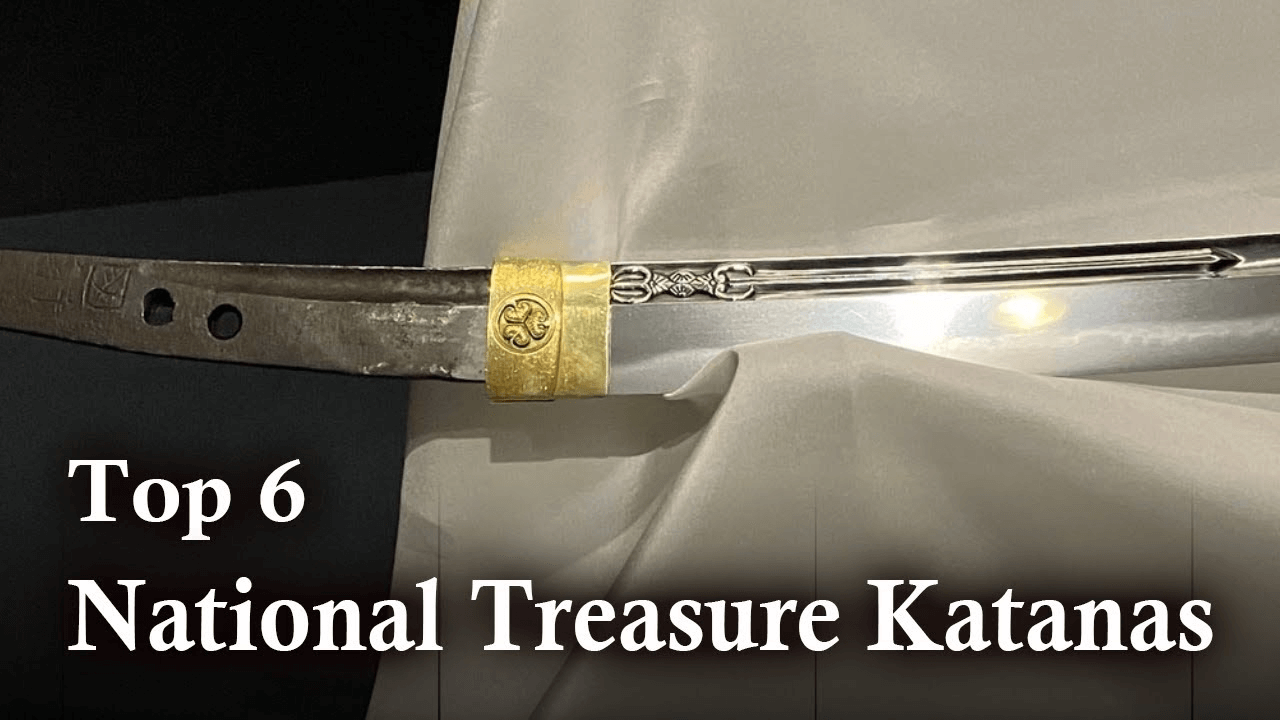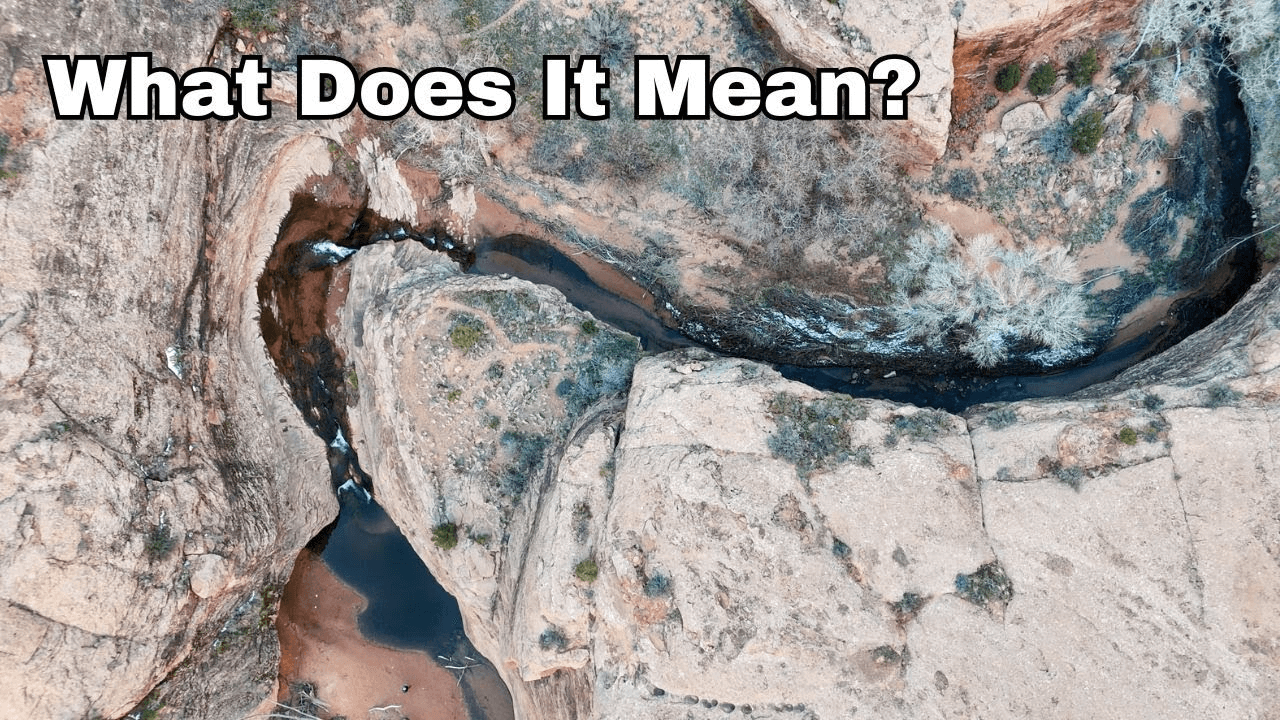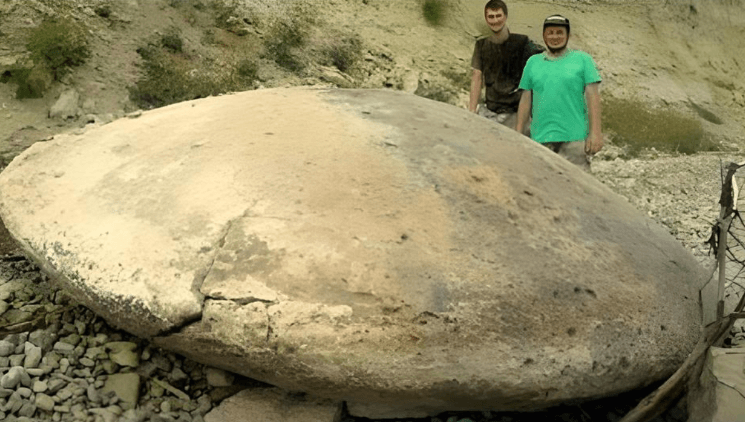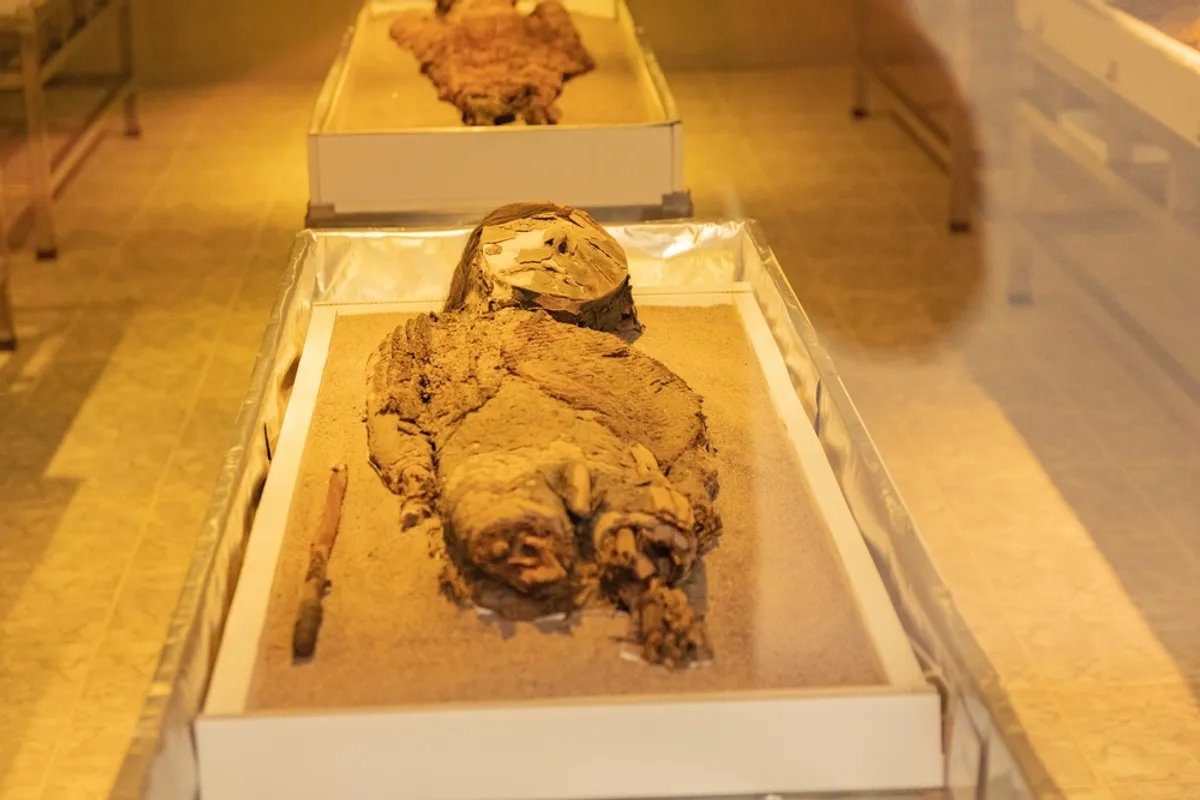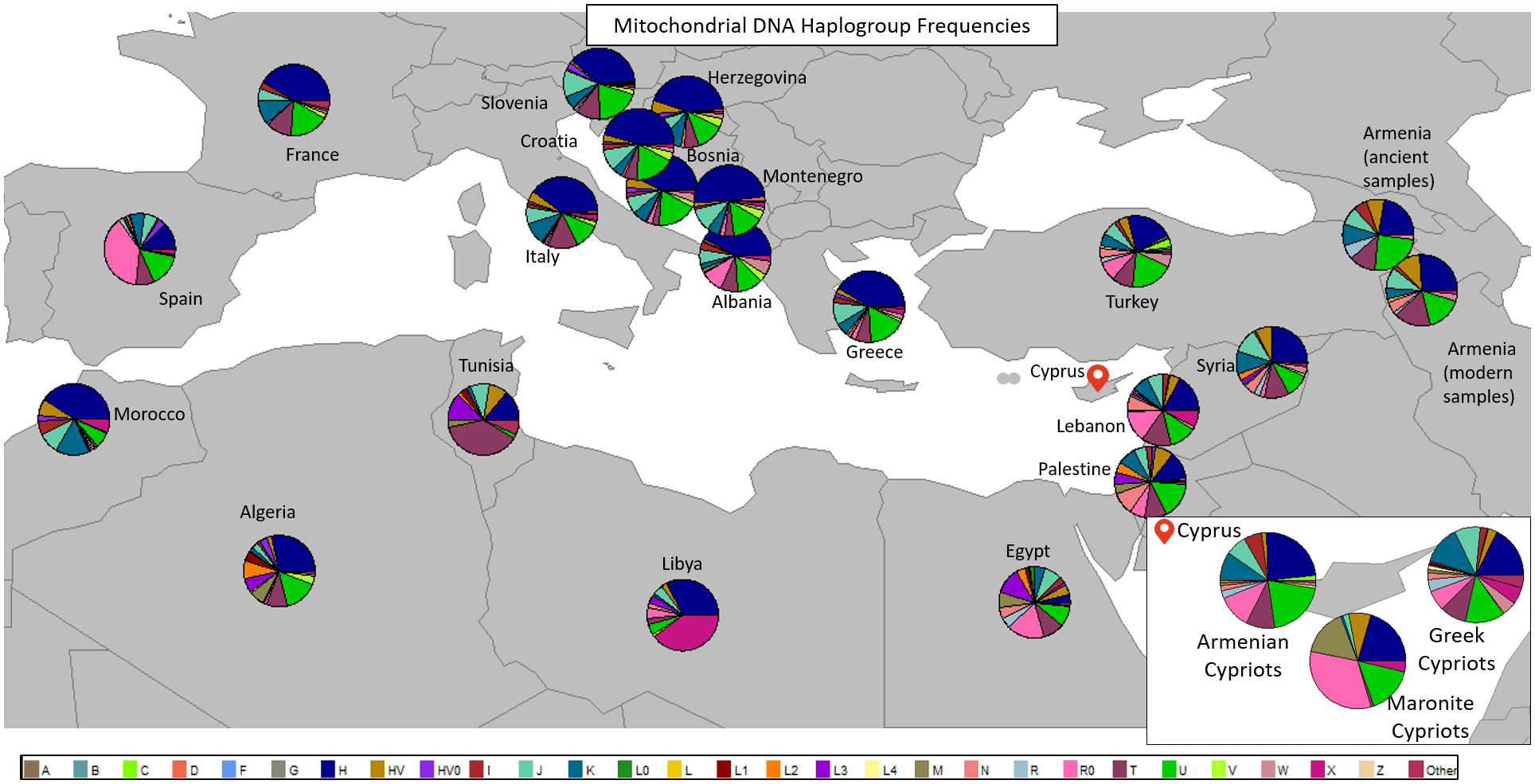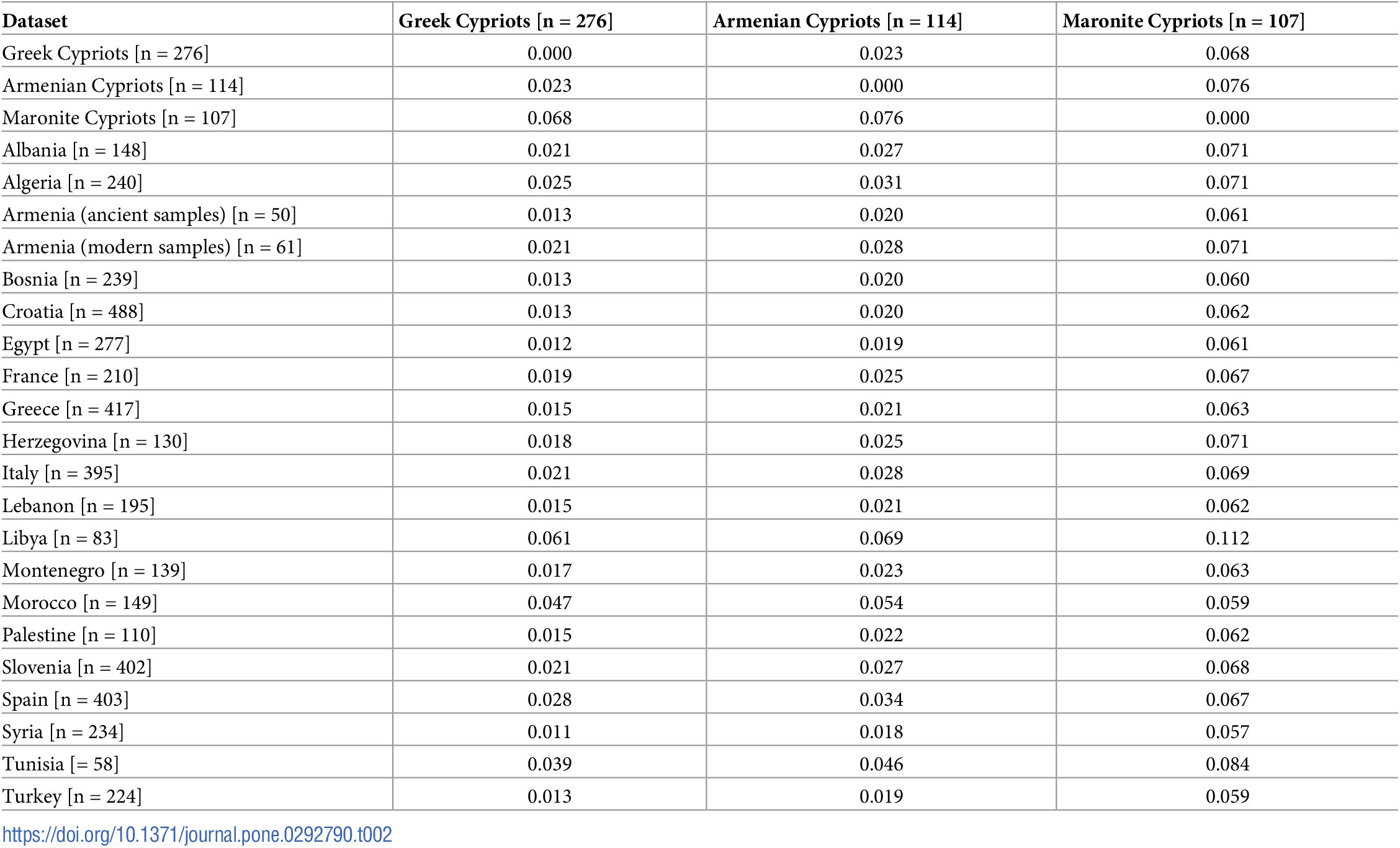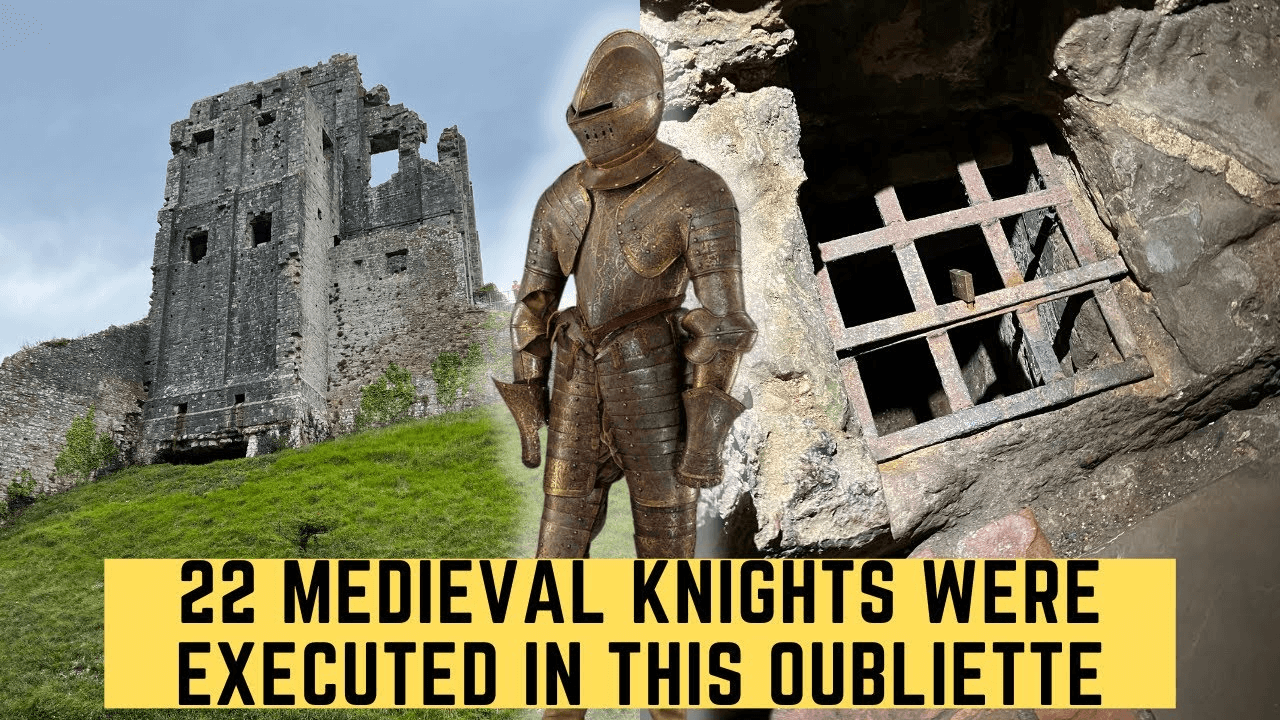In modern-day Japan, a wealth of renowned swords from various periods in Japanese history continues to endure. These remarkable blades are carefully safeguarded within shrines, museums, and private collections across the country. Of these, those possessing exceptional historical significance are honored with the prestigious designation of "National Treasure." Presently, Japan proudly acknowledges 122 swords bestowed with this esteemed title, each representing a cherished piece of the nation's cultural heritage.
Intricate Network of Human Life Found on Google Earth
In this video, we delve into the fascinating journey of an explorer who stumbled upon a hidden gem in the desert while scouting for new hiking trails. Intrigued by reports of abundant water sources and caves, the author embarked on a solo expedition to unravel the mysteries of this untouched terrain.
As he ventured deeper into the desert, he stumbled upon ancient remnants etched into the rocks - petroglyphs and pictographs dating back an estimated 800 to 1200 years. The presence of these ancient artworks hinted at a rich cultural history waiting to be uncovered.
Further exploration revealed a concentration of footprints in the canyon, leading the author to speculate about their significance, possibly clan symbols left behind by ancient inhabitants. The area's ecosystem also boasted a thriving population of bighorn sheep, revered by ancient tribes for their symbolic power and strength.
Ascending to a towering alcove, the author stumbled upon evidence of ancient agricultural practices, with numerous grinding areas where grains and corn were processed. Among the intricate rock art, he encountered a captivating depiction of a figure adorned with a necklace, painted in striking hues of blue.
In awe of the area's natural beauty and the depth of its historical tapestry, the author reflected on the privilege of exploring such a rich and complex landscape. Join us as we unravel the secrets of this desert oasis and marvel at the wonders hidden within its rugged terrain.
The Filthy Amusements of Egyptian Pharaohs
In this video, we delve into the lesser-known aspects of ancient Egyptian history, shedding light on the less glamorous truths behind the veil of Pharaonic grandeur. Despite being revered as divine figures, the pharaohs were not immune to human desires and frailties. Polygamy was commonplace among them, with some even resorting to marrying their own siblings in a bid to consolidate power within the royal family.
The corridors of power in ancient Egypt witnessed a dark underbelly, where unchecked authority often led to hedonistic excesses and disturbing practices. From opulent banquets that mocked the struggles of the common people to displays of ruthless power and cruelty, the lives of these god-kings were shrouded in a cloak of extravagance that shocks modern sensibilities.
As we explore the depths of ancient Egyptian society, we uncover scandalous behaviors and taboo practices that challenge our perceptions of this ancient civilization. Join us as we reveal the dirty truths about ancient Egypt, including the prevalence of family inbreeding among the ruling elite, shedding light on a side of history often overlooked in mainstream narratives.
Asking Tribal Elders Life's Big Questions
Mike engages in a conversation with Mpisi, a local traditional healer in Zimbabwe, emphasizing the significance of indigenous knowledge and natural resources for overall well-being. Mpisi passionately encourages individuals to acquire survival skills and cultivate their own sustenance and remedies, aiming to avoid dependence on the external world. He expresses concern that modern civilization can potentially render people vulnerable and less intelligent, pointing out the chemical-laden nature of urban food.
In contrast to city life, Mpisi prioritizes his health and vitality by cultivating his organic produce and incorporating a variety of herbs into his diet. He firmly believes that maintaining harmony with nature is essential for human happiness, contrasting the perceived chaos and lack of consideration in city living. Mpisi advocates for communal cooperation, emphasizing the value of sharing both food and joy with others.
As a devoted naturalist, Mpisi holds the belief that natural resources possess inherent healing properties, while cautioning against the potential harm chemicals may pose to the body. His lifestyle choices reflect a commitment to a holistic approach to health, rooted in a deep respect for the environment and an understanding of the interconnectedness of all living things.
6 Mysterious Historical Discoveries of 2015
In this video, we explore the intriguing encounters historians and archaeologists often have with enigmatic discoveries while delving into historical texts or unearthing ancient remains. Some of the most baffling historical findings and revelations of 2015 include:
A rare metal believed to be from Atlantis was salvaged from a shipwreck off the Sicilian coast. The metal, likely originating from Greece or Asia Minor, was possibly en route to port when it encountered a storm.
Mysterious stone discs, estimated to be around a million years old, were unearthed in Russia's Vrad region. Containing traces of the metal tonson, these discs fuel speculation about extraterrestrial involvement in their creation.
Inside a 1,000-year-old Buddha statue in China, researchers discovered the mummified remains of a monk, possibly indicative of a form of self-mummification practiced by ancient monks.
Thermal irregularities detected within the Great Pyramid of Giza hinted at potential hidden chambers or treasures concealed within its structure, offering tantalizing prospects for further exploration.
Uncovered in the Turpan Basin of northwestern China were approximately 200 mysterious stone circles, potentially dating back as far as 4,500 years, adding to the area's mystique and historical significance.
New evidence suggests that Stonehenge may have had its origins in Wales, challenging previous assumptions about its construction and purpose.
Enjoy!
12 Most Incredible Recent Archaeological Finds
Archaeology offers a wealth of fascination, with recent discoveries holding a special allure. While past findings have garnered extensive scrutiny, the allure of uncovering secrets in recent excavations remains undiminished. Fortunately, the field has witnessed a surge of captivating archaeological revelations in recent years. Below, we delve into some of the most compelling discoveries to date.
The Sumerian Queen's Lyre, The Earliest Lyre Ever Found
The Dawn of Music: The Sumerian Queen's Lyre, a Testament to Ancient Musical Ingenuity
In the annals of musical history, few artifacts hold as much mystique and significance as the Sumerian Queen's Lyre. Discovered in the Royal Cemetery at Ur, this ancient stringed instrument, dating back to approximately 2600 BC, provides a fascinating glimpse into the early development of music and craftsmanship in one of the world's oldest civilizations. This article delves into the discovery, significance, and enduring legacy of this extraordinary piece of ancient history.
Discovery and Historical Context
During his significant excavations at Ur in the 1920s, Sir Leonard Woolley discovered the Sumerian Queen's Lyre. These excavations, which revealed a trove of artifacts, provided an unprecedented insight into Sumerian culture and practices. The lyre, found among other items in what is believed to be a royal burial, is particularly notable for its intricate design and construction.
The Queens Lyre, British Museum
Design and Craftsmanship
The lyre's design is emblematic of the advanced artistic capabilities of the Sumerians. Its most striking feature is the finely crafted bull's head, symbolizing strength and fertility in Sumerian culture. The instrument's body, made from wood, was adorned with intricate inlays of precious materials, such as lapis lazuli, shell, and red limestone, creating a visually stunning artifact.
Musical Significance
As one of the earliest known stringed instruments, the Sumerian Queen's Lyre offers valuable insights into the musical traditions of ancient Sumer. Its discovery suggests that music played a significant role in Sumerian society, potentially used in religious rituals, royal ceremonies, or as a form of entertainment. The lyre's design also provides clues about the evolution of musical instruments and the origins of string-based music.
Preservation and Display
After its discovery, the lyre underwent extensive restoration, as it was found in a decayed state. Today, it resides in the British Museum, serving as a key exhibit and attracting scholars and enthusiasts from around the world. Its preservation allows contemporary audiences to connect with an aspect of Sumerian culture that would otherwise have been lost to time.
Bull's head of the Queen's lyre from Pu-abi's grave, PG 800, at the Royal Cemetery at Ur, Southern Mesopotamia, Iraq. British Museum, Osama Shukir Muhammed Amin FRCP(Glasg) - Own work
the World's Oldest Stringed Instruments in the Lyres of Ur
Few discoveries have captured the imagination of historians and music enthusiasts alike as profoundly as the Lyres of Ur. These remarkable string instruments, unearthed from the Royal Cemetery at Ur in modern-day Iraq, stand as silent witnesses to the dawn of musical expression in human civilization.
The Lyres of Ur are hailed as the world's oldest surviving stringed instruments. Strictly speaking, the collection comprises three lyres and one harp, although they are commonly referred to as lyres. Following meticulous restoration efforts, the instruments found their homes in prestigious museums across the globe. The "Golden Lyre of Ur," also known as the "Bull's Lyre," takes pride of place in the Iraq Museum in Baghdad. Its resplendent golden bull head, adorned with inlaid nacre and lapis lazuli, speaks to the exquisite craftsmanship of its creators. Meanwhile, the "Bull-Headed Lyre" in the Penn Museum, Philadelphia, with its gold foil-wrapped features, pays homage to the Mesopotamian reverence for divine symbolism.
The Queen's Lyre and the Silver Lyre, from the Royal Cemetery at Ur, southern Mesopotamia, Iraq, British Museum, London. Osama Shukir Muhammed Amin FRCP(Glasg) - Own work
The saga of the Lyres of Ur extends beyond mere archaeological significance; it intertwines with poignant tales of human connection. Leonard Woolley's excavation revealed the lyres nestled among the skeletal remains of ten women, suggesting their ceremonial use in burial rituals. One poignant discovery recounts a skeleton found resting against a lyre, its hand seemingly poised where the strings once resounded.
A lyre, by definition, is a stringed instrument characterized by a projection from the body. In order to play the lyres of Ur, specifically box lyres, one must stand upright and pluck the strings with both hands. With eleven strings each, these instruments produced a distinctive buzzing noise, likely accompanying songs performed during burial ceremonies.
The Sumerian Queen's Lyre is not just an artifact; it is a bridge to our shared human past. Its strings, though silent for millennia, still resonate with the ingenuity and artistic spirit of the people who created it. As one of the oldest known musical instruments, it continues to inspire and enlighten, reminding us of the universal language of music that transcends time and culture. The journey of the Lyres of Ur resonates with contemporary audiences across the globe.
Valle Dei Templi: A Journey Through Ancient Greece
Nestled near the sun-kissed shores of Sicily's southern coast, the Valle Dei Templi beckons travelers on a journey through time—a captivating testament to the enduring legacy of ancient Greece in the heart of Italy.
Designated as a UNESCO World Heritage site, the Valley of the Temples stands as a majestic tribute to the grandeur of Greek civilization in Southern Italy. Just beyond the bustling city of Agrigento, this archaeological marvel unfolds, revealing a panorama of exquisitely preserved ancient Greek temples.
But the Valle Dei Templi is more than a mere collection of ancient ruins; it is a living testament to Sicily's rich cultural heritage. Each year, thousands of visitors are drawn to its storied landscape, enraptured by the echoes of a bygone era when this land thrived as a vibrant hub of Greek civilization.
Stepping into the valley, visitors are transported back in time, wandering amidst the awe-inspiring remnants of temples dedicated to the gods and goddesses of the Greek pantheon. The site's strategic location offers sweeping vistas of the surrounding countryside, enhancing its allure and inviting contemplation of ancient splendor.
For those versed in Sicily's history, the significance of the Valle Dei Templi is unmistakable. It stands as a poignant reminder of the island's storied past—a testament to the enduring influence of ancient Greece on its cultural landscape.
The History of the Valley of the Temples
Founded in the 6th century BCE by Greek colonists, the ancient city of Akragas flourished as a beacon of Greek civilization in Magna Graecia. It was during this era of prosperity that the temples of the Valle Dei Templi were erected, symbols of the city's devout religious practices and architectural prowess.
Among the valley's most iconic structures is the Temple of Concordia, a masterpiece of Doric architecture dating back to the 5th century BCE. Its pristine preservation offers a glimpse into the ingenuity of ancient Greek craftsmanship, while nearby, the Temple of Hera stands as a testament to the enduring spirit of Greek devotion.
Further afield, the Temple of Heracles and the Temple of Olympian Zeus bear witness to the island's tumultuous history, their weathered columns standing as silent sentinels to a bygone era of glory and conquest.
Visiting the Valley of the Temples Today
Today, the Valle Dei Templi welcomes visitors from around the world, offering a journey of discovery through the annals of ancient history. Amidst the fragrant citrus groves and wildflower-strewn hillsides, travelers can explore the remnants of a civilization that shaped the course of Western thought and culture.
Guided tours and informative exhibits provide invaluable insights into the valley's rich heritage, while the surrounding landscape offers a serene backdrop for contemplation and reflection.
As the sun sets over the valley, casting its golden glow upon the ancient stones, one cannot help but marvel at the enduring legacy of the Valle Dei Templi. It is a testament to the enduring power of human creativity and ingenuity—a timeless reminder of the splendor of ancient Greece amidst the rolling hills of Sicily.
An ancient bronze hand found at Irulegi in northern Spain
Juantxo Egana
Deciphering an Ancient Enigma: The Irulegi Hand's Linguistic Mystery
In the heart of the Pyrenees, nestled amidst the rugged terrain of northern Spain, lies a relic that has sparked intrigue among archaeologists and linguists alike—a 2000-year-old bronze hand adorned with inscriptions shrouded in mystery.
Unearthed in July 2021 atop the hill of Irulegi, this enigmatic artifact offers a tantalizing glimpse into the ancient past. Initially discovered amidst excavations of a medieval castle, the hand's origins trace back even further to a bygone settlement from the Iron Age, dating between 1500 and 1000 BC.
Measuring 14 centimeters in length, 12.8 centimeters in width, and a mere 0.1 centimeters thick, the bronze hand bears cryptic inscriptions etched into its surface—a testament to an ancient language lost to the sands of time.
Among the inscriptions, one word stands out: "sorioneku," a term reminiscent of the Basque word "zorioneko," meaning "of good fortune." Could this linguistic parallel unlock the secrets of the Basque language's origins, long shrouded in mystery?
While some scholars, like Mattin Aiestaran of the University of the Basque Country, see compelling similarities between the Irulegi inscriptions and Basque vocabulary, skepticism lingers among the linguistic community. Céline Mounole and Julen Manterola, prominent linguists, caution against hasty conclusions, citing the scant evidence and the complexity of linguistic analysis.
Indeed, the challenge lies in the limited corpus of words inscribed on the bronze hand, leaving researchers grasping for more substantial comparisons with known languages. The tenuous link between "sorioneku" and "zorioneko" offers but a glimpse into a linguistic puzzle fraught with uncertainty.
The Irulegi hand, bearing an inscription in a mysterious language
Mattin Aiestaran, et. al.
Nevertheless, the implications are profound. If the inscriptions indeed herald a language related to Basque, it could rewrite the narrative of Europe's linguistic landscape, challenging long-held assumptions about linguistic evolution and cultural heritage.
As the debate rages on, fueled by academic scrutiny and scholarly curiosity, one thing remains clear—the Irulegi hand holds the key to a linguistic enigma that transcends time and borders. With each inscription unearthed and each word deciphered, the ancient past beckons, inviting us to unravel its mysteries and uncover the rich tapestry of human history hidden within.
Chinchorro mummies look a little different to their more famous Egyptian counterparts.
Image credit: cristianzenon/Shutterstock.com
Unveiling Chile's Ancient Mummies: A Treasure Trove Predating Egypt's Pharaohs
While the mystique of Egypt's mummies captivates the world, nestled within Chile's Atacama Desert lies an even older secret—the mummified remains of the Chinchorro people, dating back a staggering 7,000 years.
When thoughts drift to mummification, Egypt's elaborate rituals often take center stage. Yet, it's the Chinchorro people who pioneered this ancient practice, establishing their legacy as the earliest practitioners of mummification on Earth.
Originating around 5450 BCE, the Chinchorro thrived as a maritime society along the coasts of modern-day Chile and Peru. Their groundbreaking funerary customs, entombing their deceased in the arid desert sands, set them apart as innovators in the realm of preservation.
Today, these ancient burial sites stand as UNESCO World Heritage sites, offering a window into a civilization long past. Unlike Egypt's exclusivity in mummification, the Chinchorro extended this reverence to all members of their community, symbolizing a profound cultural ethos.
So, how did the Chinchorro achieve their remarkable preservation? Unlike the Egyptians' intricate embalming processes, Chinchorro mummification involved meticulous skinning and organ removal, followed by reapplication of the skin and elaborate wrappings. Clay masks adorned their faces, complemented by human hair wigs, ensuring a dignified passage into the afterlife amidst the desert's embrace.
The journey to uncover these ancient relics began in 1917 when Max Uhle stumbled upon the first Chinchorro mummy on a windswept beach. Carbon dating techniques later confirmed their antiquity, sparking a fervent quest for more discoveries.
Over a century later, hundreds of mummies have emerged from the desert's embrace, some unearthed by the relentless march of urbanization, others by the curious noses of wildlife. In Arica, where the Chinchorro legacy lives on, these ancient inhabitants are not just relics but integral threads in the fabric of local heritage.
However, the specter of climate change now looms large, threatening to unravel the delicate balance between preservation and decay. Rising temperatures and erratic weather patterns expose these ancient graves to the ravages of time, prompting urgent calls for preservation efforts.
As leading expert Bernardo Arriaza laments, museums grapple with an overwhelming influx of artifacts, while the mummies themselves face new perils within their climate-controlled confines.
Yet, amidst these challenges, a beacon of hope emerges—a state-of-the-art museum, poised to safeguard these ancient treasures for generations to come. With a price tag of $19 million, this climate-controlled sanctuary near Arica promises to shield the Chinchorro mummies from the ravages of time, ensuring their legacy endures.
In the heart of Chile's desert sands, a timeless tale unfolds, where ancient mummies stand as silent sentinels to a bygone era, beckoning us to preserve their legacy for the ages.
Historical Discovery: Lost Village Revealed During Forestry Operation on Isle of Skye
A remarkable archaeological discovery has emerged on the Isle of Skye as the remnants of a lost village, believed to date back to the 17th or 18th century, were unearthed during a specialized forestry operation.
Twenty eight buildings were recorded by AOC Archaeology's survey. Pic: Forestry and Land Scotland © Other
Nestled in Glen Brittle, the site, known as Brunell, lay obscured beneath a dense Sitka spruce plantation planted in 1977, until Forestry and Land Scotland (FLS) commissioned an archaeological survey ahead of the tree harvesting.
This once-thriving settlement, adorned with houses, byres, barns, and corn-drying kilns, had a bustling community of approximately 2,250 individuals engaged in farming activities, including cattle, sheep, and horses, to sustain their livelihoods.
However, historical records indicate a decline in population over time, with census data revealing a gradual decrease to 1,769 inhabitants before the village's ultimate abandonment. It is speculated that the shift towards consolidating smaller farms into larger grazing areas for sheep played a role in the village's decline and eventual abandonment.
FLS, in collaboration with AOC Archaeology, meticulously surveyed the area, documenting 28 buildings, some of which had been concealed by windblown trees over the years. The findings guided the careful planning and execution of the tree-felling operation, with measures in place to safeguard the historic ruins from damage.
Pic: Forestry and Land Scotland© Other
As a result, cleared areas now reveal some of the uncovered buildings, while others remain nestled beneath the forest canopy, preserving the rich history of this lost village for future exploration and study.
This remarkable discovery sheds new light on the island's past and underscores the importance of preserving and uncovering its hidden treasures for generations to come.
Adam Savage Meets Real Ancient Swords!
In this captivating video, we join Adam on a thrilling journey through the hallowed halls of the Metropolitan Museum of Art's Arms and Armor conservation lab. Previously, he experienced the awe-inspiring sensation of touching historical armor, embodied by the formidable armored gauntlets. Now, in a momentous return, associate conservator Sean Belair bestows upon Adam yet another unparalleled privilege: an intimate encounter with a collection of period swords tracing their lineage back to the 13th century.
With bated breath and trembling anticipation, Adam steps into the realm of antiquity, where each blade resonates with the echoes of centuries past. As he delicately cradles these relics of bygone eras, he becomes immersed in the rich tapestry of history, tracing the evolution of craftsmanship and martial prowess through the ages.
In this extraordinary experience, Adam not only beholds these venerable weapons but also becomes an active participant in their narrative, forging a visceral connection with the past. With each sword he handles, he embarks on a voyage of discovery, unlocking the secrets of their design, construction, and the hands that once wielded them in battle.
Through the expert guidance of Sean Belair and the Metropolitan Museum's dedication to preserving cultural heritage, Adam's encounter transcends mere observation, evolving into a profound communion with the essence of history itself. As he bids farewell to these storied blades, he carries with him a newfound reverence for the legacy they represent, forever enriched by this extraordinary journey through time.
Unearthed: Dead Sea Scrolls - The Dark Truth
The serendipitous discovery of the Dead Sea Scrolls in 1946 by a Bedouin in desert caves unveiled a treasure trove of ancient texts dating back to the time of Jesus Christ. These venerable scrolls, revered as the oldest biblical manuscripts in existence, find their sanctuary within the hallowed confines of the Shrine of the Book at the Israel Museum, drawing nearly a million pilgrims annually to behold their sacred wisdom.
For seven decades, scholars have been enraptured by the enigmas enshrouding these scrolls. Who penned them? What impelled their concealment in the desert's embrace? Do they portend a cataclysmic apocalypse? These questions have fueled scholarly discourse and captivated imaginations.
Pioneering advancements in multispectral imaging technology have unveiled latent layers of meaning within the text, offering unprecedented insights into their cryptic contents. Through the lens of the Scrolls, a radiant illumination is cast upon the milieu of Jesus' Judaism and the nascent stages of Christianity, illuminating the intricate tapestry of faith and tradition.
Yet, amidst the revelations, a veil of mystery persists. Dr. Eshbal Ratzon and an international consortium of scholars embark on a quest to decipher fragmented scrolls, seeking elusive clues to unravel the secrets of their authorship and clandestine concealment. These fragments stand as silent sentinels guarding the untold narratives of antiquity, beckoning humanity to peer beyond the veil of time and uncover the mysteries that lie within.
The mystery of the biggest mammalian land carnivore to ever live...
This video delves into the intriguing tale of Andrew Sarkus Mongali Enus, the largest land predator ever unearthed. Its discovery, nearly a century past, during an expedition in Mongolia, unveiled a creature of formidable proportions. Initially pegged as a member of the Mesonychids, a diverse group of mammals spanning small to large sizes, further scrutiny four decades later revealed Andrew Sarkus's true kinship with the Uintatheres, colloquially dubbed "hell pigs."
The enigmatic nature of Andrew Sarkus is compounded by its solitary status within the Andrew Sids group, making it a challenge to reconstruct its full anatomical profile. Clad in fur and boasting feet adorned with lightly hooved appendages ensheathed in keratin, this behemoth of the ancient world possessed a disproportionately massive head atop a body reminiscent of generic mammalian anatomy, evoking imagery somewhere between a hippopotamus and a formidable carnivore.
Thriving amidst the subtropical forests of China during the Eocene Epoch, approximately 47.8 to 41.2 million years ago, Andrew Sarkus shared its domain with a diverse array of fauna. Its neighbors included various species of artiodactyls, perissodactyls, catfish, freshwater turtles, crocodilians, and towering flightless birds, painting a vivid picture of a lush prehistoric ecosystem teeming with life.
While direct findings and close relatives of Andrew Sarkus remain elusive, the genetic legacy of its extinct kin offers tantalizing glimpses into the creature's possible appearance and behaviors, stirring the imagination and inviting further exploration into the mysteries of Earth's ancient past.
5 Unexplained Ancient Holes
In the heart of the Yemeni desert lies a profound enigma, the Well of Barhout. This natural wonder, shrouded in mystique and dread, earns its moniker as the "Well of Hell" among locals. Picture a vast chasm, stretching over 30 meters in diameter and descending hundreds of meters into the earth's depths.
Legend intertwines with reality as folklore whispers tales of this abyss serving as a prison for demons. The air carries with it a noxious aroma, adding weight to the belief that something sinister lurks within. Even the Prophet Mohammed himself is said to have cautioned against its waters, deeming them "the worst water on the face of the Earth," amplifying the aura of apprehension surrounding the site.
Superstition weaves a tapestry of fear, warning against even the slightest proximity to its edge. Objects and individuals alike are cautioned against venturing too close, lest they become ensnared and consumed by its gaping maw. The mere mention of its existence is believed to court misfortune, reinforced by eerie accounts of inexplicable voices and unsettling sounds emanating from its depths.
Within the lore surrounding the Well of Barhout are tales of jinn, ethereal beings akin to genies, rumored to inhabit its shadows and assail any who dare to approach.
Echoes from the 13th century resound through the accounts of Ibn al-Mujawir, a traveler and merchant. He weaves a narrative linking the well to the tyrannical ruler Shaddad bin Ad, a figure enshrined in the Quran. As the story goes, Shaddad commanded two jinn to excavate a well and a water channel for a burgeoning settlement. Yet, in an act of hubris, he imprisoned them within the depths of the Well of Barhout, forever entwining their fates with this enigmatic abyss.
Archaeologists uncover ancient serpent artifact dating back 4,000 years, suggesting its potential use in rituals
Archaeologists have unearthed a snake-shaped artifact believed to have been used in ancient rituals around 4,000 years ago. Discovered by researchers from National Tsing Hua University in Taiwan, the artifact was found at a sand dune site in Guanyin District, western Taoyuan city.
The 4,000-year-old snake-shaped artifact found in Guanyin District, Taiwan. Archaeologists believe the artifact may have come from a pottery vessel that was used in ancient rituals.
The coastal location has been a treasure trove of archaeological finds dating back to Taiwan's prehistory, including a large-scale stone tool processing area. The snake artifact, described as "important," was announced on the university's archaeology news Facebook page.
Radiocarbon dating placed the artifact's age at around four millennia. Thought to be a handle from a pottery vessel, the artifact displays a vivid snake-like figure, resembling a cobra with raised head and distinctive skin folds.
Snake symbolism holds significant cultural and religious meaning across various ancient societies, symbolizing transition and the cycle of life and death. The artifact likely played a role in ritual practices, possibly serving as part of a sacrificial vessel.
Similar serpent-themed artifacts have been discovered in other regions, underscoring the widespread significance of snake imagery in ancient cultures.
Deciphering the Maternal Ancestral Lineage of Cypriot Communities: A Genetic Perspective
The island of Cyprus, nestled in the heart of the Mediterranean, has been a crossroads of civilizations for millennia, its strategic geographic location making it a jewel coveted by various conquering populations. This rich historical tapestry is reflected in the diverse genetic heritage of its inhabitants. A groundbreaking study by Moutsouri et al. (2024) published at PLOS ONE delves into the mitochondrial DNA (mtDNA) of Greek Cypriots, Armenian Cypriots, and Maronite Cypriots, offering unprecedented insights into the maternal ancestry of these communities.
Cyprus's complex history of settlement, conquest, and migration is mirrored in the genetic makeup of its people. The island has seen the arrival of Assyrians, Crusaders, Turks, and others, each leaving their mark on the genetic landscape. The introduction of mitochondrial DNA analysis into the study of Cypriot populations opens a new chapter in understanding how these historical movements have shaped the present-day genetic diversity of the island.
Fig 3. Mitochondrial DNA haplogroup frequencies among Cypriots and countries of interest.
The mappies show the haplogroup frequencies. The zoomed in portion shows the haplogroup frequencies of the tested Cypriot samples. Each haplogroup is indicated with different colour.
The study analyzed 406 unrelated Cypriot samples, revealing that Greek Cypriots and Armenian Cypriots share a closer genetic affinity compared to Maronite Cypriots. This finding suggests a nuanced genetic interplay among the communities, reflective of their distinct historical migrations and interactions. The prevalence of haplogroups H and U further underscores a shared maternal lineage that likely traces back to the Neolithic period and the Bronze Age, highlighting the deep-rooted connections between the inhabitants of Cyprus and the broader Mediterranean and Near Eastern regions.
The genetic differentiation observed among the Cypriot communities offers a fascinating glimpse into the island's history of settlement and migration. Maronite Cypriots, with their unique genetic profile, provide a compelling case study of a more homogeneous group, possibly due to their historical practice of endogamy. The study's comprehensive analysis, encompassing genetic distances, haplogroup frequencies, and migration paths, paints a detailed picture of the genetic landscape of Cyprus, revealing the intricate mosaic of its maternal ancestry.
Table 2. Calculated genetic distances between Cypriots and the countries of interest.
This research not only enriches our understanding of the genetic heritage of Cyprus but also contributes to the broader field of Mediterranean and Near Eastern genetic studies. It underscores the importance of mtDNA analysis in unraveling the complex tapestry of human migration and interaction over millennia. The findings from Moutsouri et al.'s study open new avenues for research into the genetic history of Cyprus, offering insights into the shared and distinct genetic legacies that weave together the island's communities.
As Cyprus continues to stand at the crossroads of civilizations, its people embody the genetic legacy of its rich and tumultuous history. This study marks a significant step forward in understanding the genetic diversity of the island, shedding light on the maternal lineages that have shaped the identity of its inhabitants. The implications of this research extend beyond the shores of Cyprus, offering a window into the broader narrative of human migration and settlement in the Mediterranean and the Near East.
22 Medieval Knights Were Executed In This Oubliette
Today, we explore the dark history of the oubliette, a grim and brutal form of execution where prisoners were confined to tiny dungeon cells and left to be forgotten. Within the walls of Corfe Castle lies one such infamous oubliette, where during the reign of King John and the Medieval Period, 22 knights met their demise.
Join us as we delve into the chilling tale of "22 Medieval Knights Were Executed In This Oubliette".
SHOCKING Discoveries in Egypt, Which no one Expected!
Embark on an enthralling journey through the sands of time as we reveal Egypt's top 15 astonishing discoveries that still puzzle the world. From impressive technological feats to intriguing enigmas, Egypt's rich historical legacy has made an enduring impact on humanity.
Our exploration begins with the iconic Nefertiti statue, which was unearthed in 1912 by a German archaeological team in Amarna. Explore the contents of Borchardt's notebook, detailing the heated dispute between German and Egyptian authorities regarding the return of this remarkable artifact.
Delve into the mystery surrounding Nefertiti—a figure wrapped in intrigue, believed by some to be of royal descent. Was she a visiting princess or the descendant of the respected Ay, who assumed the throne after Tutankhamun? Unravel the twists and turns in Nefertiti's narrative, from speculation about her fate during Akhenaten's reign to her unexpected reign as a ruler after her husband's death.
Join us as we unravel the secrets of Egypt's past and uncover the mysteries that continue to captivate audiences worldwide. Subscribe now to witness the unveiling of our top 15 astonishing discoveries in Egypt!
12 Most Incredible Ancient Artifacts Finds
Our ancient artifacts have crafted remarkable wonders throughout history. If you're already a subscriber to our channel, you're well aware of this fact, as we consistently showcase the evidence. However, if you haven't subscribed yet, today presents the perfect opportunity to join us! We're embarking on another fascinating journey into the distant past, and we've unearthed some truly spectacular finds to share with you. Don't miss out – the adventure begins now!

